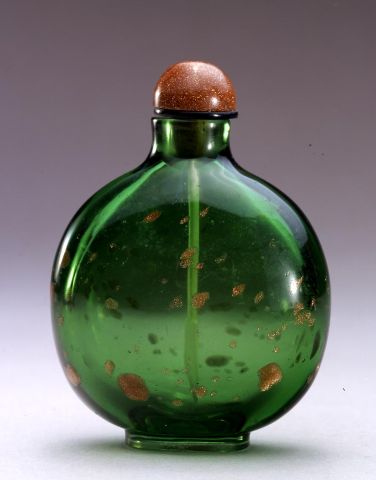
Bottle ID: 00138
GREEN EMERALD, TRANSPARENT W/SPLASHES OF AVENTURINE
Date: 1730-1795
Height: 52 mm
Glass, of rounded bulbous form, with a slightly everted lip and with a neatly carved oval footrim, of transparent emerald-green color, the outer surface with irregular splashes of aventurine glass.
Imperial, attributed to the Palace Workshops, Beijing.
Similar Examples:
Snuff Bottles - The Complete Collection of Treasures of the Palace Museum,
Vol. 47, p. 78, no. 126.
Holden, Rachelle R. Rivers and Mountains Far From the World - The Rachelle R. Holden Collection, 1994, p. 382, no. 179.
Chinese Snuffbottles from the Collection of Joseph Baruch Silver, in Conjunction with the Exhibition at the Israel Museum, Jerusalem, Winter 1987, p. 11, no. 8.
Provenance:
The Chinese Porcelain Company, New York
Exhibited:
Annual Convention ICSBS Toronto, October 2007
Published:
The Chinese Porcelain Company, New York, Chinese Bottles and Jade Carvings from the Douglas, Gnam and other Collections, 1992, p. 6, no. 3
From the early days of the Imperial glasshouse there was an interest in what we today call aventurine glass or glass interspersed with gold flecking. This developed as early as 1705 when aventurine or gold flecked glass is mentioned in Palace records. The Kangxi Emperor on one of his official tours that year arrived in Suzhou where he presented Song Luo with seventeen pieces of glass which included two blue glass snuff bottles flecked with gold. However, documentation relating to the Palace Archives mentions only five colors of glass in the Kangxi period - clear, red, yellow, blue and sky-blue. The Bloch Collection has a black bottle with aventurine splashes with an accepted Qianlong nianzhi mark on its base and it seems more comfortable to place this group in that reign. What at first appears as a fairly simple plain piece of glass is, in reality, a sophisticated example of established manufacture. Some aventurine glass is made with what is termed a sandwich technique where the aventurine is trapped between a base layer of colored glass and a top surface layer of clear glass. However, on this example the green glass bubble would have been blown, had the gold added to the outer layer and then the whole bottle re-worked. In this case, the aventurine glass has remained on the outer surface of the piece. This bottle is unusual in that most bottles of this group are produced in a clear blue color with aventurine splashes, although other colors include green, purple, yellow and black.
< Back to full list
 English
English 中文
中文